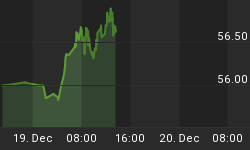PRECIOUS METALS - As per my expectation, the bull-market is powering ahead due to monetary inflation and the accelerating debasement of currencies. Gold is now trading close to $800 per ounce and the yellow metal is likely to continue its advance until spring next year. At today's level, adjusted for inflation (even using the understated inflation figures released by the Federal Reserve), gold is still roughly 65% cheaper than where it was in 1980. If you adjust the price of gold in terms of the real inflation we have witnessed over the past 27 years, the price of gold would have to rise several-fold from these levels. Now, I am not saying with any certainty that this is going to take place, but I want you to be aware of the potential should the public wake up to the inflation menace.
In the realm of precious metals, silver seems to be even more undervalued when compared to gold. Figure 1 highlights that when adjusted for inflation (even using the understated inflation figures released by the Federal Reserve), silver is still 85% below its all time-high recorded in 1980. I do not know about you, but I certainly do not classify this as a "bubble"! In the months and years ahead, I expect silver to rally hard and outperform gold. Moreover, I suspect that the ongoing consolidation will be followed by a bullish tidal wave which will catapult both metals to significantly higher levels.
Figure 1: Silver on the bargain table!

Source: www.thechartstore.com
I continue to believe that the best returns in the precious metals universe will be made by investing in the mining companies as they provide the leverage. So far in the bull-market, a basket of precious metals mining stocks have outperformed bullion by 250%! Accordingly, we have taken exposure by investing our clients' capital in miners rather than physical bullion.
Although the AMEX Gold Bugs Index went up by roughly 50% before the recent correction commenced, I suspect it still has room to rise much further in the coming months. Figure 2 highlights that after breaking out of a multi-month consolidation phase (defined by the yellow shaded area), this index is testing its previous high recorded in May 2006 and should continue to rally for the foreseeable future.
In its next meeting, I expect the Federal Reserve to cut its interest rate and this should act as the catalyst to propel the AMEX Gold Bugs Index to much higher levels. Now is the time to invest heavily in precious metals mining companies as I expect fat profits in the weeks ahead.
Figure 2: Precious metals stocks rallying hard!

Source: www.stockcharts.com
When the Federal Reserve embarked on its rate-cutting journey in August, it might as well have set alight a few US Dollar bills on national television. Let there be no doubt; by slashing interest-rates in the face of a sinking Dollar, the Federal Reserve has made it absolutely clear that it does not care about the health of its currency. It is more interested in creating more inflation and giving the illusion of prosperity through even higher asset-prices. Whilst this is a tragedy for Americans, it is also an opportunity if you can invest your capital in appropriate assets and currencies.
To add to the Dollar's woes, it is estimated that approximately US$1 trillion worth of US Dollar holdings will be reallocated to other currencies over the next half decade. This development should weaken the US Dollar further, especially against the Asian and Latin American currencies.
I maintain my position that the US Dollar is in a lengthy bear-market which will see its value erode considerably against the "emerging" currencies and the currencies of the commodity-producing nations. Earlier this year, I recommended the Canadian Dollar as a good option. Back then, it was trading at 0.85 versus the US Dollar. Today, it is trading at parity versus the US Dollar and should appreciate further in the coming months.
In summary, get rid of your US Dollars by either buying tangible assets or switching to more favourable currencies in Asia, Canada, New Zealand Dollar and Australia.
We are living in a highly inflationary environment where central bankers seem to be competing against each other to see who can make their currency worthless before the others. So, avoid exposure to cash and fixed income assets which will not be able to sustain the purchasing power of your hard-earned savings. In fact, I would argue that bonds are now in a secular bear-market and will decline as interest-rates rise.
If you have not done so already, allocate a large part of your total net-worth to hard, tangible assets including energy, metals, water and food.















